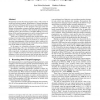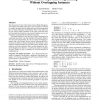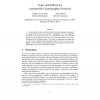226 search results - page 32 / 46 » Types, Subtypes, and ASL |
ICFP
2010
ACM
13 years 8 months ago
2010
ACM
Programmers reason about their programs using a wide variety of formal and informal methods. Programmers in untyped languages such as Scheme or Erlang are able to use any such met...
ICFP
2010
ACM
13 years 8 months ago
2010
ACM
Type classes have found a wide variety of uses in Haskell programs, from simple overloading of operators (such as equality or ordering) to complex invariants used to implement typ...
CSFW
2002
IEEE
14 years 11 days ago
2002
IEEE
We present the first type and effect system for proving authenticity properties of security protocols based on asymmetric cryptography. The most significant new features of our ...
ENTCS
1998
13 years 7 months ago
1998
We obtain a new formalism for concurrent object-oriented languages by extending Abadi and Cardelli's imperative object calculus with operators for concurrency from the -calc...
BMCBI
2010
13 years 7 months ago
2010
Background: Much of the public access cancer microarray data is asymmetric, belonging to datasets containing no samples from normal tissue. Asymmetric data cannot be used in stand...



